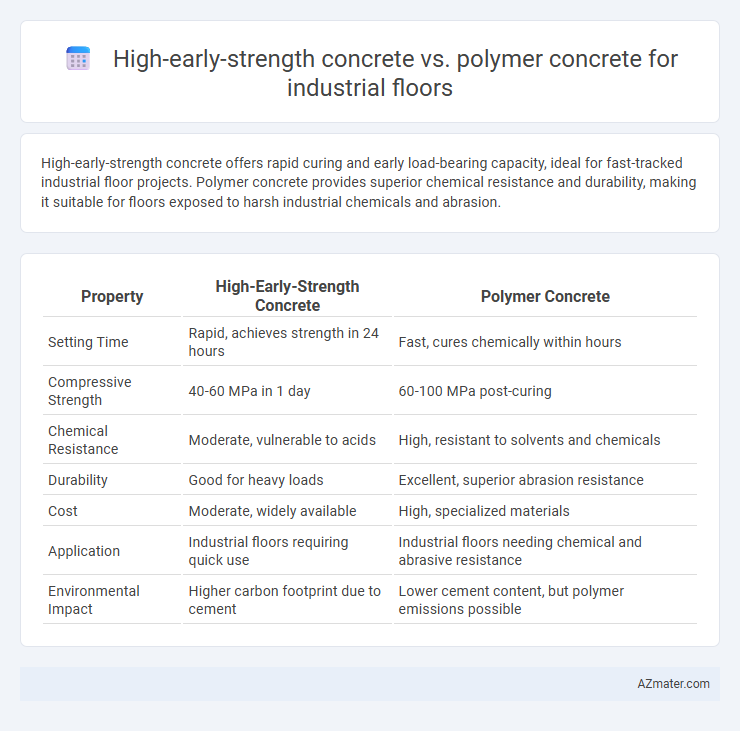High-early-strength concrete offers rapid curing and early load-bearing capacity, ideal for fast-tracked industrial floor projects. Polymer concrete provides superior chemical resistance and durability, making it suitable for floors exposed to harsh industrial chemicals and abrasion.
Table of Comparison
| Property | High-Early-Strength Concrete | Polymer Concrete |
|---|---|---|
| Setting Time | Rapid, achieves strength in 24 hours | Fast, cures chemically within hours |
| Compressive Strength | 40-60 MPa in 1 day | 60-100 MPa post-curing |
| Chemical Resistance | Moderate, vulnerable to acids | High, resistant to solvents and chemicals |
| Durability | Good for heavy loads | Excellent, superior abrasion resistance |
| Cost | Moderate, widely available | High, specialized materials |
| Application | Industrial floors requiring quick use | Industrial floors needing chemical and abrasive resistance |
| Environmental Impact | Higher carbon footprint due to cement | Lower cement content, but polymer emissions possible |
Introduction to Industrial Flooring Solutions
High-early-strength concrete provides rapid curing and early load-bearing capacity, making it ideal for minimizing downtime in industrial flooring projects. Polymer concrete offers enhanced chemical resistance and durability, suitable for environments exposed to harsh chemicals and heavy wear. Selecting between these materials depends on specific operational demands, such as curing time and exposure to aggressive substances.
Overview of High-Early-Strength Concrete
High-early-strength concrete achieves rapid strength gain by using a high cement content combined with accelerators and optimized curing conditions, enabling early load application on industrial floors. It typically reaches 70% of its design strength within 24 hours, making it ideal for fast-track construction projects requiring minimal downtime. This concrete type offers enhanced durability and abrasion resistance suitable for heavy machinery operations in industrial environments.
Overview of Polymer Concrete
Polymer concrete is a composite material that uses synthetic resins as a binder, offering superior chemical resistance, high compressive strength, and rapid curing times compared to traditional cement-based concretes. It is especially suitable for industrial floors subjected to heavy loads, chemical spills, and thermal stress due to its enhanced durability and low permeability. Unlike high-early-strength concrete, polymer concrete provides better adhesion to substrates and improved resistance to abrasion and corrosion, making it ideal for demanding industrial environments.
Key Material Properties Comparison
High-early-strength concrete offers rapid compressive strength gain, reaching up to 10,000 psi within 24 hours, making it ideal for reducing construction downtime in industrial floors. Polymer concrete exhibits superior chemical resistance and enhanced tensile strength due to its resin binder, providing excellent durability in harsh industrial environments. While high-early-strength concrete excels in fast load-bearing capacity, polymer concrete is preferred for environments requiring exceptional resistance to abrasion, solvents, and impact.
Installation and Curing Times
High-early-strength concrete typically achieves significant strength within 24 to 48 hours, allowing faster installation and earlier floor usage compared to traditional mixes. Polymer concrete, cured through chemical reactions rather than hydration, can set in as little as a few hours, enabling rapid turnaround times ideal for industrial floors requiring minimal downtime. Both materials reduce curing duration significantly, but polymer concrete offers superior speed in installation and return-to-service, critical for high-traffic industrial environments.
Mechanical Strength and Durability
High-early-strength concrete offers rapid compressive strength gain, reaching up to 20-30 MPa within 24 hours, making it ideal for fast-track industrial flooring projects. Polymer concrete exhibits superior mechanical strength with enhanced flexural and tensile properties due to its resin matrix, providing exceptional durability against chemical attacks and abrasion. While high-early-strength concrete excels in quick load-bearing capacity, polymer concrete outperforms in long-term durability and resistance to harsh industrial environments.
Chemical Resistance and Environmental Suitability
High-early-strength concrete offers rapid load-bearing capacity but generally has moderate chemical resistance, making it less ideal for environments exposed to aggressive industrial chemicals. Polymer concrete, composed of synthetic resins and aggregates, exhibits superior chemical resistance to acids, alkalis, and solvents, enhancing durability in harsh chemical environments. Environmentally, polymer concrete often contains fewer volatile organic compounds and can be formulated for eco-friendliness, while high-early-strength concrete involves higher cement content associated with greater carbon emissions.
Maintenance and Longevity Considerations
High-early-strength concrete offers rapid curing times and robust compressive strength, enabling quicker floor use but may require more frequent maintenance due to potential surface wear and susceptibility to cracking under heavy industrial loads. Polymer concrete, reinforced with synthetic resins, exhibits superior chemical resistance, enhanced durability, and reduced permeability, resulting in extended lifespan and lower maintenance demands ideal for harsh industrial environments. Selecting polymer concrete can significantly decrease downtime and repair costs, while high-early-strength concrete benefits projects with tight schedules needing immediate structural readiness.
Cost Analysis and Lifecycle Value
High-early-strength concrete offers a lower initial cost compared to polymer concrete but may require more frequent maintenance and repairs, increasing lifecycle expenses for industrial floors. Polymer concrete has a higher upfront investment due to advanced materials and specialized installation but provides superior chemical resistance, durability, and longer service life, reducing overall lifecycle costs. Evaluating total cost of ownership, including downtime and maintenance, typically favors polymer concrete for high-performance industrial flooring applications.
Choosing the Optimal Concrete for Industrial Floors
High-early-strength concrete offers rapid curing times and high compressive strength, making it ideal for industrial floors requiring quick turnaround and heavy load resistance. Polymer concrete enhances chemical resistance and durability, suitable for environments exposed to aggressive chemicals and frequent spills. Selecting the optimal concrete depends on balancing curing speed, mechanical strength, and environmental resistance for specific industrial floor applications.

Infographic: High-early-strength concrete vs Polymer concrete for Industrial floor
 azmater.com
azmater.com